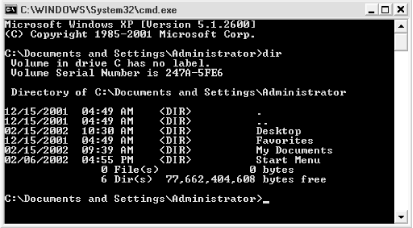Name
Command Prompt —
\windows\system32\cmd.exe
Synopsis
The Windows XP command line interface, commonly known as a DOS box.
To Open
Start → Programs → Accessories → Command Prompt
Command Prompt →
cmd
Usage
cmd [/q][/d] [/a|/u] [/e:on|off][/f:on|off][/v:on|off] /t:fg[[/s][/c|/k]string]
Description
The Command Prompt (see Figure 4-16) is a simple application in which you type commands rather than pointing and clicking. While the Command Prompt is sparse and may be somewhat intimidating to new users, it carries out several very important functions in Windows XP, including access to otherwise inaccessible programs and utilities and even some advanced file management functions. Appendix C fully documents the command prompt, its commands, and the related Address Bar.

Figure 4-16. Use the DIR command to view the contents of the current directory in the Command Prompt
Cmd accepts the following
parameters:
-
string When used with
/cor/k, specifies a command to be carried out when the command prompt window is first opened. Multiple commands can be specified here if they’re separated by&&, andstring, as a whole, is surrounded by quotation marks.Stringmust be the last parameter on the command line. See Chapter 6 for more information on the types of commands that can be typed at the command prompt.-
/c Carries out the command specified by
stringand then stops.-
/k Carries out the command specified ...
Get Windows XP in a Nutshell, Second Edition now with the O’Reilly learning platform.
O’Reilly members experience books, live events, courses curated by job role, and more from O’Reilly and nearly 200 top publishers.

